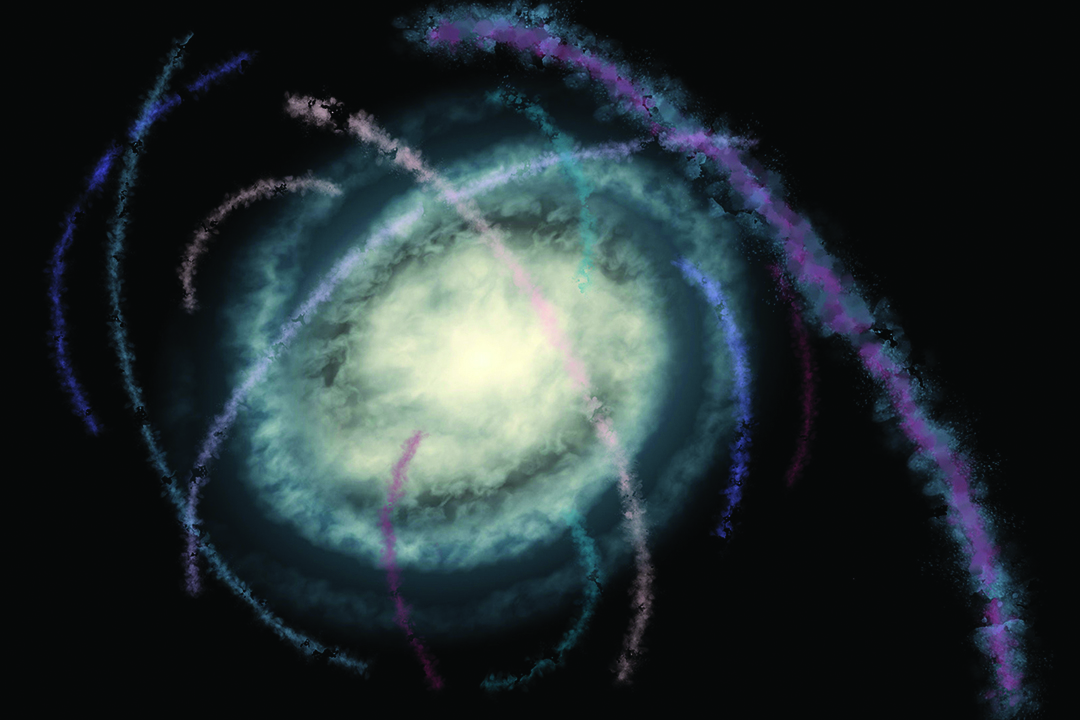An international team of astronomers, including members of U of T’s faculty, recently demonstrated how knowledge about our galaxy’s evolution can be gleaned from the orbits of so-called stellar streams. These streams are elongated rows of stars that orbit the Milky Way, which, from Earth, appear like glowing streamers arcing across the night sky.
Over the past 20 years, astronomers have identified over 60 orbiting stellar streams. However, they have been difficult to study because of their distance from Earth and the relatively low number of stars in a stream.
In 2018, a U of T-led collaboration of astronomers from around the world began to change that. They started a focused observation of stellar streams visible in the southern hemisphere using a telescope at the Australian National University in eastern Australia. Now, they have reported their findings from a dozen streams in a paper that has been accepted for publication in the Astrophysical Journal.
The streams originated from either clusters of loosely bound stars called globular clusters or small ‘dwarf galaxies.’ Collisions with the Milky Way likely pulled the streams out of their original environment and sent them into orbit, while the remaining stellar mass was absorbed by our galaxy.
Lead author Ting Li, an astrophysicist in U of T’s David A. Dunlap Department of Astronomy and Astrophysics, highlighted the importance of this finding in a press release. “This study gives us a snapshot of the Milky Way’s feeding habits, such as what kinds of smaller stellar systems it ‘eats.’ As our galaxy is getting older, it is getting fatter.”
The collaboration — known as the Southern Stellar Stream Spectroscopic Survey, or the S5 — involved observational data from the Anglo-Australian Telescope in Australia to identify streams. To pick out the distance to individual stars, the team also used data from the European Space Agency’s telescope, Gaia. Gaia is a space telescope that orbits the Sun at a distance of 1.5 million kilometres from the Earth. It provides highly accurate data because its reception is unimpeded by the Earth’s atmospheric temperature.
By analyzing the velocities and metallic composition of the streams, Li and her collaborators determined that six of their 12 streams came from globular clusters and the remaining half came from dwarf galaxies. This is strong evidence for the theory that galaxies like the Milky Way grow by merging with other smaller galaxies over billions of years.
The team was also able to infer the presence of dark matter in the original source of the streams. Dark matter is a mysterious substance that we know very little about. It is non-luminous, meaning that it neither emits nor reflects light, making it impossible to detect with traditional telescopes.
In fact, its very existence is only known because of the gravitational effects it has. For example, the close separation and high velocity of objects within the Milky Way cannot be fully explained through their own gravitational forces. That gravity alone would not be sufficient to hold everything together; stars and planets would fly out of their current orbits. Astrophysicists have long believed that the extra gravity must be coming from dark matter.
Similarly, the S5 discovered that the velocity of stars in streams could not arise completely from the Milky Way’s gravity. This suggests that there was dark matter in whatever source the streams originally came from, which helped them achieve their current velocities.
The mysterious nature of dark matter makes every incremental find like this valuable, especially as it allows astronomers to clarify where our own galaxy’s dark matter might be. Streams move following invisible gravitational forces, so by mapping those forces, we can infer the location of the dark matter producing them. This happened in 2020, when a European team sketched our galaxy’s dark matter distribution by observing stellar streams yanked from the nearby dwarf galaxy Sagittarius.
Co-author Gerraint F. Lewis of the University of Sydney compared the process to a Christmas tree in the press release. “On a dark night, we see the Christmas lights, but not the tree they are wrapped around. But the shape of the lights reveals the shape of the tree,” he said.
“It is the same with stellar streams — their orbits reveal the dark matter.”


